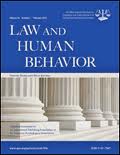 The Child Pornography Offender Risk Tool (CPORT) was significantly associated with sexual recidivism, demonstrating moderate predictive accuracy for adult male child pornography offenders. This is the bottom line of a recently published article in Law and Human Behavior. Below is a summary of the research and findings as well as a translation of this research into practice.
The Child Pornography Offender Risk Tool (CPORT) was significantly associated with sexual recidivism, demonstrating moderate predictive accuracy for adult male child pornography offenders. This is the bottom line of a recently published article in Law and Human Behavior. Below is a summary of the research and findings as well as a translation of this research into practice.

Featured Article | Law & Human Behavior | 2015, Vol. 39, No. 4, 416-429
Predicting Recidivism Among Adult Male Child Pornography Offenders: Development of the Child Pornography Offender Risk Tool (CPORT)
Author
Michael C. Seto, Royal Ottawa Health Care Group, Brockville, Ontario, Canada
Angela W. Eke, Ontario Provincial Police, Orilla, Ontario, Canada
Abstract
In this study, we developed a structured risk checklist, the Child Pornography Offender Risk Tool (CPORT), to predict any sexual recidivism among adult male offenders with a conviction for child pornography offenses. We identified predictors of sexual recidivism using a 5-year fixed follow-up analysis from a police case file sample of 266 adult male child pornography offenders in the community after their index offense. In our 5-year follow-up, 29% committed a new offense, and 11% committed a new sexual offense, with 3% committing a new contact sexual offense against a child and 9% committing a new child pornography offense. The CPORT items comprised younger offender age, any prior criminal history, any contact sexual offending, any failure on conditional release, indication of sexual interest in child pornography material or prepubescent or pubescent children, more boy than girl content in child pornography, and more boy than girl content in other child depictions. The CPORT was significantly associated with any sexual recidivism, with moderate predictive accuracy, and thus has promise in the risk assessment of adult male child pornography offenders with further cross-validation.
Keywords
child pornography offenders, recidivism, risk assessment
Summary of the Research
A five-year follow-up analysis of 266 adult male child pornography offenders was conducted to identify predictors of sexual recidivism. Variables of interest included demographic variables, index charges and convictions, criminal history, child pornography content, child pornography collecting behavior, substance use, disclosed sexual interest in children, other paraphilic interests, and overall pornography type and amount.
“To conduct this study, [researchers] coded data from the investigation files of convicted child pornography offenders. Drawing from past research on the risk factors for contact sexual offending against children, [they] hypothesized that child pornography offenders who scored higher on variables reflecting antisociality (specifically, criminal history, conditional release failure, and substance misuse), pedophilia or other paraphilic interests (specifically, self- reported sexual interest in children and child pornography content depicting prepubescent children rather than pubescent or adolescent minors), or opportunity (specifically, residing or working with children and having specific contact information about children) would be more likely to sexually reoffend. [They] then examined whether predictors of sexual recidivism identified in univariate analyses could be combined in a structured checklist for clinical and criminal justice decision makers” (p. 417).
The Child Pornography Offender Risk Tool (CPORT) was created by examining variables conceptually similar to established risk items from the Static-99, the SORAG, and previous research with child pornography offenders. Univariate analyses were used to combine variables that would be easy to code. Seven items were used: “(a) offender age at time of the index investigation, coded as higher risk if age 35 or younger (49% of the sample were higher risk); (b) any prior criminal history, coded as higher risk if yes (41% were higher risk); (c) any prior or index contact sexual offense history, coded as higher risk if yes (18% were higher risk); (d) any prior or index failure on conditional release such as probation, parole, or conditional release, coded as higher risk if yes (15% were higher risk); (e) indication of pedophilic or hebephilic interests, coded as higher risk if yes (40% were higher risk); (f) ratio of boy to girl content in child pornography, coded as higher risk if there was more (51%) content depicting boys (15% were higher risk); and (g) ratio of boy to girl content in nudity and other child content, coded as higher risk if there was more content depicting boys (16% were higher risk)” (p. 423).
Each of the 7 items was scored as 0 or 1 and then items were summed. Total “CPORT score was a significant predictor of any recidivism, any sexual recidivism, and specifically contact sexual recidivism” (p. 423). “The CPORT did not significantly predict sexual recidivism in the subgroup of offenders with only child pornography offenses but did significantly predict sexual recidivism among child pornography offenders with other offending in their history or with contact sexual offending histories” (pp. 423-424).
Translating Research into Practice
“Combining seven significant predictors of sexual recidivism, [researchers] were able to create a structured checklist that significantly predicted any sexual recidivism or specifically contact sexual recidivism at a level similar to the accuracies obtained by risk scales developed for contact sex offenders, such as the Static-99. This tool was not predictive for offenders only known to have child pornography offenses, which [the researchers] attribute to the low base rate of sexual recidivism in this subgroup for the 5-year follow-up (6% compared with 12% for child pornography offenders with nonviolent or nonsexually violent offending histories or 23% for child pornography offenders with contact sexual offending histories), resulting in low statistical power to detect an association.
Although [these researchers] report probability estimates for this development sample, cross-validation of the CPORT is needed to assess its use as an actuarial measure for child pornography offender sexual recidivism. Also, further validation with larger, independent samples and longer follow-up times could evaluate the generalizability of the CPORT or suggest improvements. The low base rates of sexual recidivism, especially contact sexual recidivism, found for child pornography–only offenders suggests that it would be difficult to validate a risk-assessment tool for this specific population. As with other sex offenders, treatment and supervision of child pornography offenders should be based on a comprehensive assessment of risk and other considerations (e.g., access to children) for each individual. Child pornography offenders with antisocial characteristics, emotional congruence or identification with children, or ideas supportive of sex with children may be considered in greater need with regard to risk management and treatment priorities.
Though more work is needed to cross-validate risk factors identified in this research and to examine other risk factor candidates not included in the current study, [these researchers] believe the CPORT can be useful in the structured risk assessment of adult male child pornography offenders as a preferable alternative to unstructured risk judgments. Actuarial use of the CPORT involving application of the recidivism probabilities reported here is not recommended without further cross-validation” (p. 427).
Other Interesting Tidbits for Researchers and Clinicians
“Closer examination of individual START items revealed that those with the best predictive potency differed between men and women. S9 (impulse control) seemed a particularly relevant item for males, being among the most predictive items for all outcomes; DBT strategies such as behavioural analysis, distress tolerance skills, and emotion regulation have been suggested as possible treatment targets for impulsivity and may prove useful in reducing aggression and self-harm in males” (p.141).
“Interestingly, there was no correspondence between the key Strengths or critical Vulnerabilities identified in either sample, and the most predictive items for the relevant group. This suggests that, at least at a group level, the items which clinicians are identifying as most important to the case in hand are not those that demonstrate the greatest predictive ability. It is likely that clinicians are giving extra weight to items identified as key or critical when forming their specific risk estimates. If this is the case, the current analyses suggest that although the specific risk estimates have reasonable predictive efficacy among the female samples, the items may not be being considered in the optimal manner. It is reasonable that the items identified as the most potent predictors at the group level may not be the most relevant items in all individual cases, particularly when individuals have low scores on these items” (p.142).
Join the Discussion
As always, please join the discussion below if you have thoughts or comments to add!






















